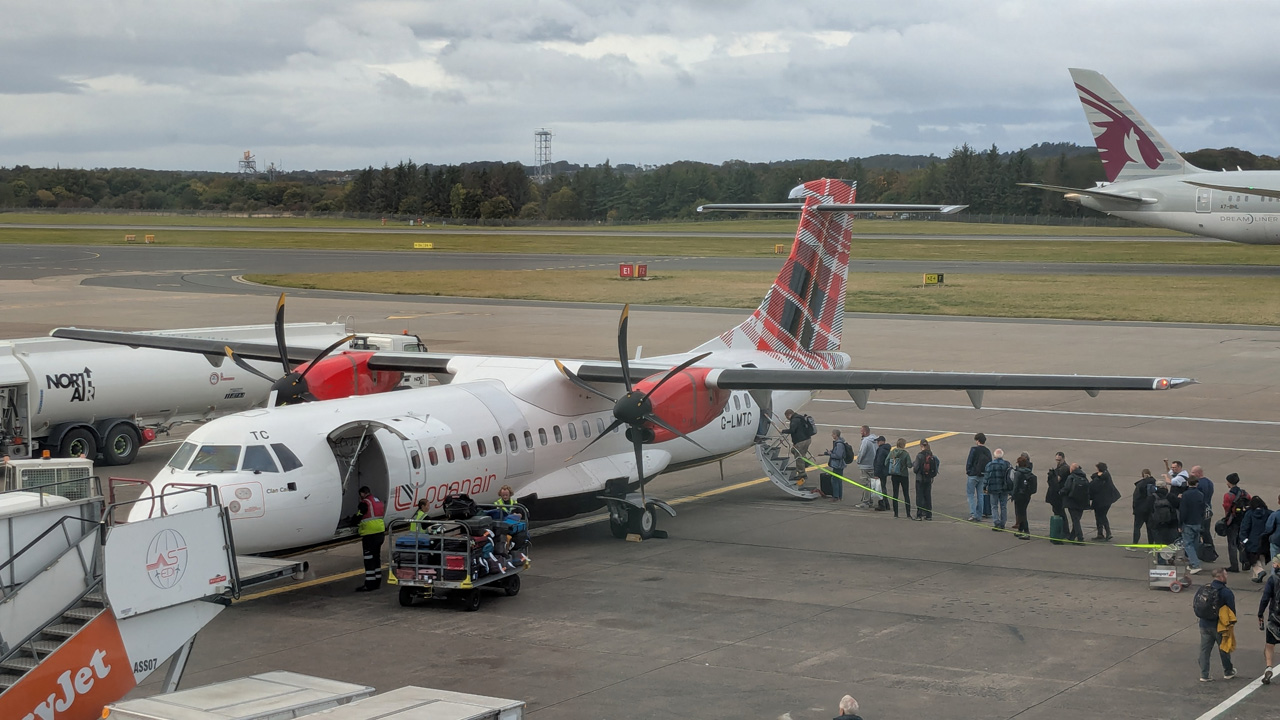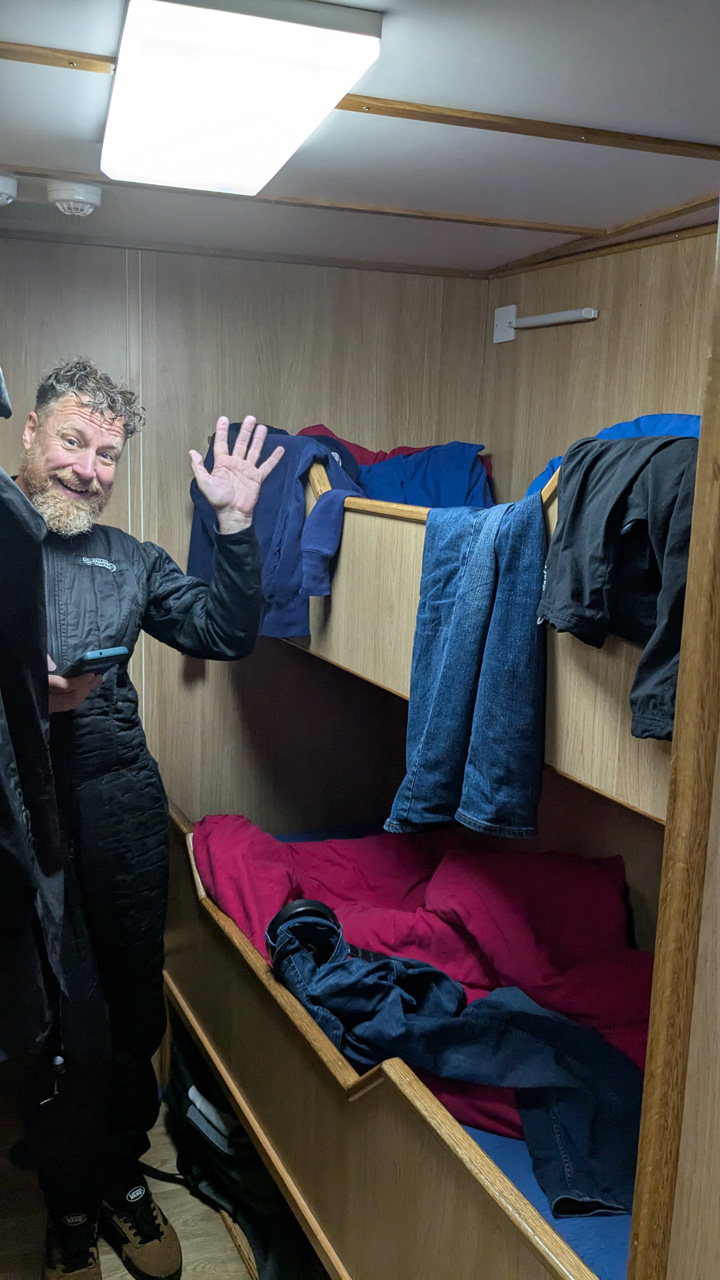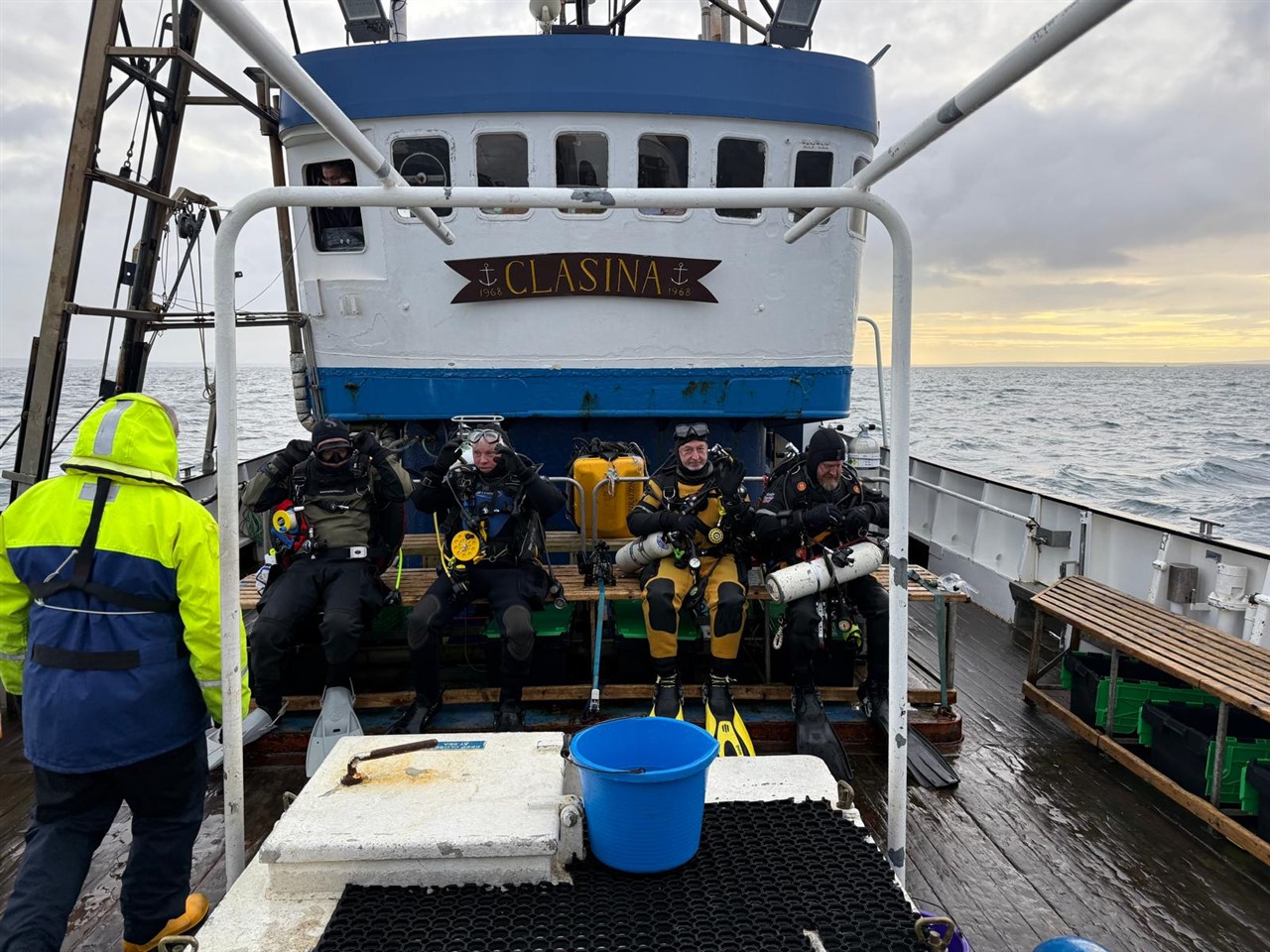Diving - My Continuing Adventures underwater
Back to Scapa Flow - October 2025
Back in 2012, I'd visited Scapa Flow to dive the remaining scuttled ships of the WW1 German Fleet, deliberately sunk by the Germans under guard in 1919, when they feared the ships would be seized by the Allies and put to use.
I'd greatly enjoyed the diving, but I was very inexperienced then and I had marvelled at the divers with twin sets and carrying out accelerated decompression with rich Nitrox mixes and said to myself that I would return one day and dive the wrecks again with such equipment to get hour long dives on the majority of the wrecks.
My final words of my review of the trip were "One thing's for certain - I'll be back in Scapa Flow sometime."
When Caroline suggested a trip, I, along with 6 other club members, decided that this was the time.
This time we would be staying onboard the boat we were diving from, albeit returning to Stromness harbour each evening.
Testing, Testing
I had planned to carry out a refresher ADP dive from Swanage in early September, but it was blown out, again, so I decided to take a trip down to Vobster in late September to check out my twinset regs (I would be renting my cylinders locally) and reacquaint myself with diving with Twin cylinders and a stage.
I dived with fellow club member, Rob, who had bought himself a secondhand drysuit and wanted to try it out after spending 5 weeks working on reef restoration in Indonesia.
We went in and descended to the top of the tunnel - Vis was terrible and it took me a while to work out where I was!
Eventually, we swam past the Ford Escort, to the plane and then through the concrete tubes to the top of the crushing works.
After that, we descended down the side of it and then along to the Jacquin wreck and the Wheelhouse and then to the Sea King.
After a quick swim through that, we headed up to the top of tunnel.
Rob still had plenty of air, so we descended down the tunnel and then up the side of the Crushing works to the top of the tunnel and safety stop area.
Rob couldn't hold the stop (I think his dry suit valve was closed) and surfaced, I completed my stop and we exited via some steps in the schools area, but it was slippery and tricky with my twins and pony, that I'd taken in to test my stage regulator.
After a bacon sandwich and a cup of tea, we dropped in in front of shop, my feet hitting the rock with the weight of my twins and a low water level, swimming over the 25M pit to the wheelhouse.
From there we went down the line to the remains of the caravan and then followed the line to the small yacht.
I headed off the bow and we found the second wheelhouse and a Jester, but vis was very poor.
I spotted a line I hadn't seen before and it led us to the Sea King again.
From there we ascended up and found ourselves back at the Escort, so we swam to the crushing works, descended down inside and out through the small hole in the bottom and then went back up the tunnel.
There were a lot of divers in terrible vis at the usual safety stop point and we'd struggled getting out on the first dive, so we swam over to a platform near the confined area to complete our stop and then exited via the ladder in front of the shop, which was easier than the slippery rocks near the schools area, even with my twins on.
There was horrible vis (sub 2M on the whole) on both dives, but Rob was pleased with his new (to him) drysuit and I had no problems with my twinset/stage kit or diving in my twins again after a long break.
Scapa bound once more
Some of our party had a Transit van and offered to carry our kit for a contribution to their petrol, while most of us flew to Kirkwall, so I'd packed with duplicates of nearly everything, including drysuits and undersuits, but then Storm Amy (the tail-end of a hurricane) arrived in Scotland our plans fell apart with a day to go!
The ferry suddenly wasn't running and the only spaces available on the Sunday (we expected to arrive on the Saturday) were for foot passengers, so all of a sudden we needed to get our dive gear on a plane!
So, there was much repacking and purchasing of extra luggage to be done.
The next afternoon, with around 16 hours to my flight, I received a text to say the flight was cancelled!
I rushed to the BA website, but that was no help, so I rang them and after a half hour call, I managed to arrange to fly the same route (Heathrow - Edinburgh - Kirkwall) on the Sunday, instead of the Saturday.
The winds looked far calmer by then and I'd only lose a day's diving.
As it turned out, I didn't lose anything. Most of the others were heading up on Friday afternoon, to Aberdeen, staying one night there and then flying into Kirkwall on Saturday to start diving Sunday.
Their flight left, but after two abortive attempts to land in Aberdeen, diverted to Inverness, where they spent hours on the plane before being unloaded to an empty airport and sent by taxi back to Aberdeen airport!
They reached their hotel about 2AM, but the flight to Kirkwall was cancelled anyway!
John and Tom gave up the struggle to reach Scapa and took BA's offer of a refund and flew home, but Andy persevered and arrived in Kirkwall just before me, with Caroline, Issy and Saby.
My flight up, in contrast, was smooth, except for a slight scare at Edinburgh, where my clothes arrived on the reclaim conveyor but my dive gear didn't - I was, eventually, told it was checked all the way to Kirkwall and, fortunately, that proved to be the case when we arrived.

Boarding the flight to Kirkwall in Edinburgh
So, a day late, we were in Stromness and on board the Clasina dive boat, but should we have come? Opinions were divided, but I was determined to make the most of my return to Scapa Flow.
Dive 1 : SMS Dresden
Conditions on the Clasina were rustic and basic, our cabins were tiny, although dry (not always true of liveaboards!), the bunks a bit hard and we had to share washing up duties - I commented to Mandy that it was like youth hostelling; in the 1980s!

It's not the Maldives Aggressor!

The 'lounge' was pretty cramped, too, but the food was very good.
But I hadn't really expected Maldives Aggressor style luxury - I was here to dive and the first dive was on SMS Dresden one of the 4 cruisers still in Scapa Flow from the 1919 German Fleet scuttling.
I dived all week with Andy Taylor, my 'partner in crime' on 2024's adventure to the Galapagos Islands.

Kitted up and ready to go
We're both BSAC Advanced Divers and planned to do a lot of the dives using Accelerated Decompressions Procedures (using rich Nitrox mixes to speed up deco time), but for the first couple of dives, we stuck to twin 12s filled with Nitrox, just to get used to things.
The Clasina is a remarkably stable boat to dive from, as we were to find out later in the week, but our first day was on a calm sea with blue sky between broken clouds. It was actually a nice day to go diving!

The first morning delivered sunshine and blue skies
Andy and I descended to the bow near to the capstans, where the bow is peeled back ,so we entered for a better look at the mechanism close up.
We then started to swim along deck side of wreck towards the stern, which lies on its side.
We passed the armoured 'battle bridge, one of the masts lying on the seabed and various other sites of interest on the wreck.
A video of our dive on SMS Dresden
When we reached the area of the wreck where salvage had extensively broken it up, we swam across the wreck and found ourselves eventually on top, looking at the portholes of the officers accommodation to the rear of the wreck and to the stern itself.
As I looped around the stern, I spotted a tube and swam down to examine it and discovered it was actually one of the aft deck guns.
At this point Andy indicated he had 8 minutes deco, so we started to ascend via the shot on the stern of the wreck, having covered most the length of the ship in one dive.
We carried out our deco and safety stop and surfaced to return to the boat.
I'd enjoyed the first dive, some sights were familiar from my visit 13 years previously, but with more experience and a lot more gas, I was able to explore the wreck more extensively and, unsurprisingly, this was rewarding.
Everyone was buzzing after the first dive and we enjoyed an excellent lunch, cooked by Ben who provided great lunches and dinners all week.
Dive 2: F2 and YC21 barge
After the deep and long dive on the Dresden cruiser, we had a gentle but very enjoyable dive on the F2 (a WW2 German Escort vessel) and the barge that had been moored nearby and used to store items unloaded from the from German ship.
We came down near the bow of the F2 and explored a few holes into the interior of the wreck, before heading aft. Andy called me back when we reached the area damaged by later salvage and pointed out one of the deck guns below us.
We then returned and turned around the bow of the F2, continuing along the keel until we reached the line linking it to the barge, which we followed.
Here I spotted a Ling on the seabed and we explored the side a little, looking for Congers which I recalled seeing a lot of on my previous visit to the wreck, 13 years before.
We didn't find any, so ascended up the side and then dropped down into the area where the AA gun from the F2 was stored, but the other divers had already stirred the silt up here and the vis was very poor.
A video from the dive on the F2 and YC21
However, to one side of the gun I saw some machinery in an area with better vis so swam over this and found myself in an area with very good vis and the remains of what looked like bulkheads, where a lot of fish were found.
I'd lost Andy at this point, but he was nearby and I could see his light so turned around and showed him that area again.
We then swam on and found what looked like the lower mechanism of a turret (probably an AA gun from reading) and then something linked to a concrete block by a rope, that looked very like a large propellor boss and blade.
We returned across the wreckage and then along the rope back to the F2, where we penetrated into a confined area and then out of a hole in the lower patrt of the hull near the seabed - We were near the bow here, so took a bit more video and then returned to ascend via the shotline with no deco incurred.
Dive 3: SMS Coln
The first day had gone well, so Andy and I got the 7L stages we'd ordered from Bob, Clasina's skipper, filled with 50% Nitrox and started to carry out some of our dives using Accelerated Decompression (ADP), where we switch to the richer O2 mix to force Nitrogen from our bodies at a faster rate than with the gas we use at depth alone.
Oxygen, unexpectedly, is toxic above a certain pressure, so you cannot just breathe a very rich mix at depth.
We descended the shotline onto one of the davits for one of the launches the Cruiser carried and then looked down to seabed, where it looked like we could see the collapsed remains of a structure for the AA gunners.
We turned towards the stern, passing over the area wrecked by salvage and then we came across two guns in quick succession and then the stern which was very intact and remarkably narrow.
We then turned around and headed along mid deck level passing over lots of wreckage, but little that I recall as particulary memorable before nearing the bow, where Andy indicated he has 9 minutes deco (I only had 3 at this point due to a less conservative setting on my computer).
I spotted an interesting looking pipe slightly below us and swam down to it, which turned out be the fore, starboard gun which I took a quick look at before realising I was below the MOD for my gas and that Andy was indicating we should ascend.
A video from our first dive on the Coln
We returned to the shotline on the davit, switched gas on the way up to 51% for accelerated deco and completed 14 minutes to satisfy Andy's computer's requirements.
This was a really good dive and, reassuringly, with no ADP muddles after a long lay off from doing such dives.
Dive 4: SMS Karlsruhe
As we'd been getting very different decompression requirements on our computers, I switched mine to the medium setting, which would limit my bottom time, but, I hoped, mean Andy and I had similar lengths stops as I was getting bored, cold and need of a pee waiting for him to complete his!
The Karlsruhe is the shallowest of the Cruisers in Scapa Flow.
The seabed was around 25M and we found ourselves near the forward capstans.
Andy and I went to the bow, having missed this section on the other cruisers, but it was disappointingly incomplete, so we turned around and quickly found ourselves with most of the other divers from our group on the two forward guns, which, in good light and reasonable visibility were very easy to examine.
We then headed aft, penetrating into a couple of areas within the wreck, along the way, which featured considerable equipment that I wasn't able to easily identify, but which may have included a boiler room.
We headed to the stern, where I was keen to see if the planking I remembered was stil in place. It was, but the deck itself was more broken up and the planking equally disturbed.
We then headed forward again and I found a complicated piece of equipment, possibly part of the transmission to the propellors, I tried to swim in but there wasn't room, so I backed out and then found another entry a little forward that let me approach from the other direction.
We then continued forward, passing a wrecked steam turbine and other parts of the ship before I spotted the armoured 'battle bridge' which I'd missed on the way astern, but photographed on my previous visit. I took some video, but got separated from Andy at this point.
A video from our first dive on the Karlsruhe
I couldn't see him and came to the conclusion that I needed to launch my DSMB and ascend alone, but as I unclipped it I spotted his twin dive lights ahead, slightly above and off to the right of the wreck, which I knew meant he was on the shotline, so I swam up to him and we ascended, able to complete our (now near identical) decompression commitments with just a 3 minute safety stop after switching to 51% deco gas on the way forward from the stern,
Being shallower, the vis and light were better on this wreck than the others, but the damage to the ship was greater (having been more extensively salvaged).
Most of the group felt this was the best dive so far and it was certainly good, bringing back memories from my dive on the wreck 13 years before, but Andy and I prefered the dive in the morning on the more intact Koln.


